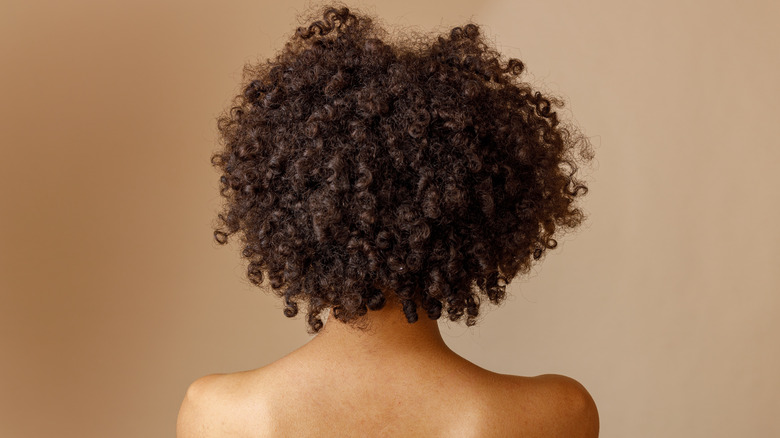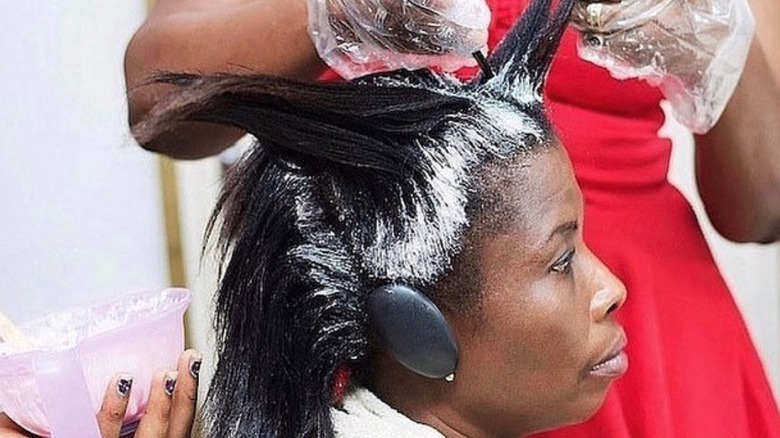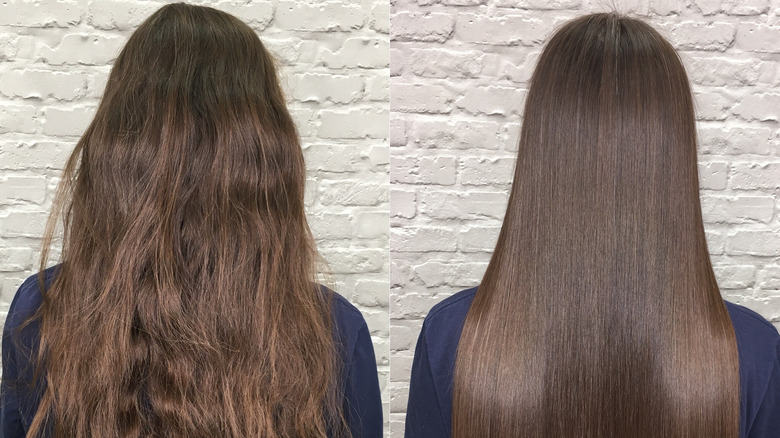What's The Difference Between Relaxers And Texture Releases? Here's What To Know
Hair trends are a never-ending occurrence in the beauty world. Whether you're rocking the fun-loving baby braids or the gorgeous asymmetrical bob, trying new looks is always fun. One great way to spruce up your hair is by taking it from curly to straight. As we know, this can be achieved through flat irons, blow drying, silk presses, or more permanent means such as relaxers and texture releases.
The latter two became a topic of discussion thanks to TikToker Nellie Robert, who shared a video of her texture-released hair. While this process is similar to a relaxer — leaving the hair bone straight — and they both offer a wide range of benefits, they have many distinctions. So how can you be sure which is right for your curly or coiled hair? That depends on whether or not you're comfortable with strong chemicals.
Texture release relies heavily on heat
When beauty influencer Nellie Robert demonstrated her texture release, the results were flawless. The healthy, silky bob flowed so well that many within her TikTok comment section were confident that she'd gotten a relaxer, which chemically strips the hair's texture. However, textured hair specialist Kash Bishop with Neville Hair & Beauty says people don't have to go the harsher relaxer route in order to smooth their hair.
"With a texture release treatment, clients will be able to achieve styling versatility while maintaining natural texture between blow-dries," Bishop told Stylist UK.
The results of the texture release may not endure as long as a relaxer — they could last between eight to 12 weeks due to milder chemicals, amino acids, and glyoxylic acid only temporarily loosening tight strands. While these ingredients are usually harmless, Bishop advises anyone dealing with scalp irritation or skin conditions such as psoriasis to steer clear of this treatment, as it may cause some discomfort.
Relaxer uses stronger chemicals for permanent results
Relaxers use sodium hydroxide or calcium hydroxide to alter the hair's natural texture permanently. Most people go for this option if they desire to make their thick curly locks tamed with no frizz. The results are stunning, leaving a delicate feel to the strands. While this is considered a permanent straightening method, touch-ups are required almost every six to eight weeks. This is usually the time when your roots grow out, and if left unstraightened, they will not properly blend with the rest of the hair.
Due to the chemical usage, going to a professional — at least until you're comfortable with the technique — is highly recommended. Speaking with Naturally Curly, Texas-based hairstylist Latara Porch says one benefit of having your relaxer done in a salon is getting a "strand test." This will determine how strong your hair is, which can better help you choose the type of relaxer that's best for you. Porch also says that salons frequently keep track of the type of treatments clients receive to ensure they are on a consistent routine.
How do you know which one is right for you?
Now that you know the difference between relaxers and texture releases, how can you tell which is right for you? If you're satisfied with temporary straightening and still want to enjoy your curls from time to time, then texture release is the sure way to go. If you're seeking permanent straightening, then a relaxer is your go-to. Keep in mind that the only way to revert your hair after a relaxer is to cut it and start anew.
Though relaxers are mostly safe, some that contain endocrine disrupters have raised concerns. These can interfere with women's hormones, which could cause severe illnesses such as ovarian and breast cancer, as outlined by the Journal of the National Cancer Institute's recent study. Another factor to consider is how much your hair can withstand. If you have dry, brittle hair, a relaxer may not be the proper straightening treatment. Even a texture release may be too harsh if your hair is severely damaged. Before straightening your hair in any capacity, consult with a licensed stylist to see which remedy is best for you.
In some cases, you may benefit from a protein treatment before applying a semi-permanent or permanent straightener. Whichever direction you go in, don't be afraid of relaxers and texture releases. Simply educate yourself in preparation for your new look.


